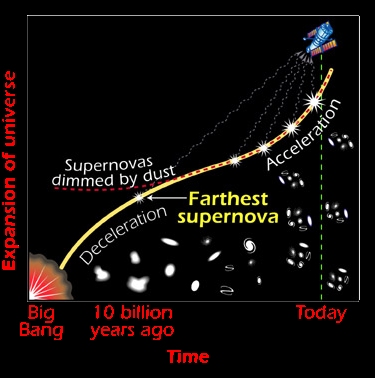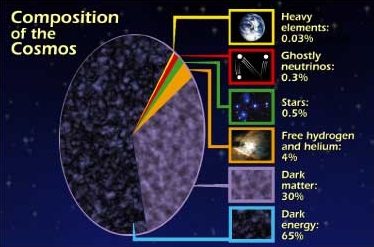

This graph plots the size of the universe over time as measured by Hubble Telescope observations of exploding stars, called supernovas, at various distances from Earth. Hubble's study of exploding stars several billion light-years from Earth [white objects at far right of curve] set the stage for observations of more distant supernovas [white object at far left of curve].
Supernovas are used to map the expansion of the universe -- the rate at which galaxies are moving apart.
Several exploding stars discoverd four years ago provided evidence that the cosmos was accelerating.
These objects looked dimmer than expected because they were hurtling away from Earth at faster speeds.
The faraway supernova at far left, residing 10 billion light-years from Earth, appears brighter than astronomers predicted.
This finding indicates that the supernova is so far away it existed at a time when the cosmos was slowing down.
If dust in space were making the supernovas appear dimmer, the expansion rate would have plotted along the dotted red line.

This diagram shows the ingredients that make up the universe.
Astronomers now realize that the universe's main ingredient is "dark energy", a misterious form of energy that exists between galaxies.
The next largest constituent is dark matter, which is an unknown form of matter.
The rest of the universe consists of ordinary matter. Most of it is locked up in stars and clouds of gas.
A tiny fractiion of this matter is composed of heavier elements, the stuff of which humans and planets are made.
Credits: NASA,
Adam Riess (Space Telescope Science Institute, Baltimore, MD)
For more information, pictures, animations, and interviews relative to this release, link to the original
Blast from the Past: Farthest Supernova Ever Seen Sheds Light on Dark Universe
(at the Web site of the STScI).
![]() Updated: April 4 '01
Updated: April 4 '01
Best seen with MS Internet Explorer.
Back: ARVAL - Gallery: Blast from the Past